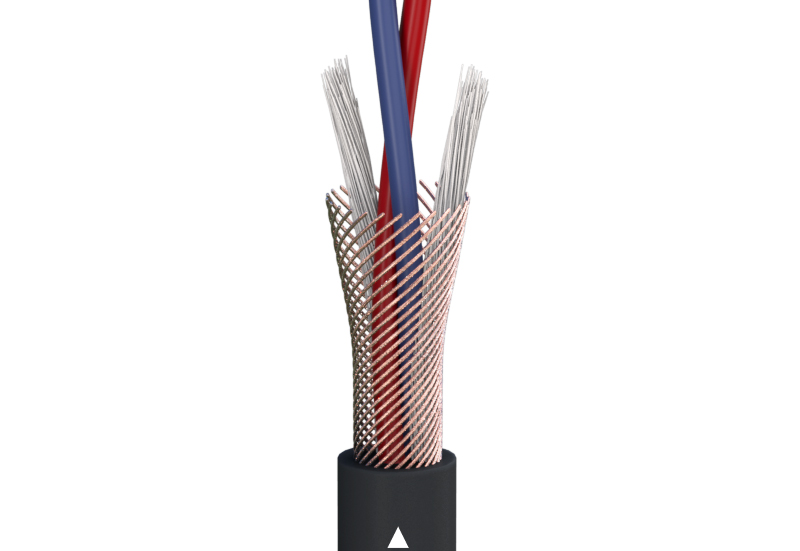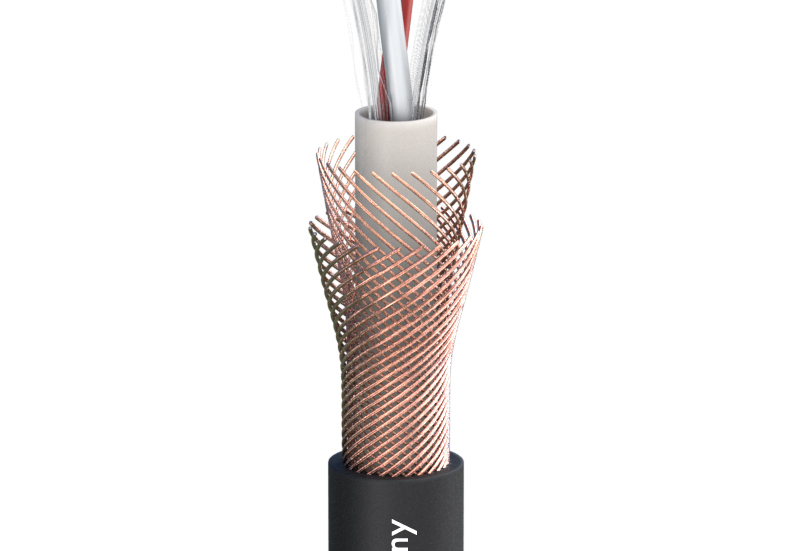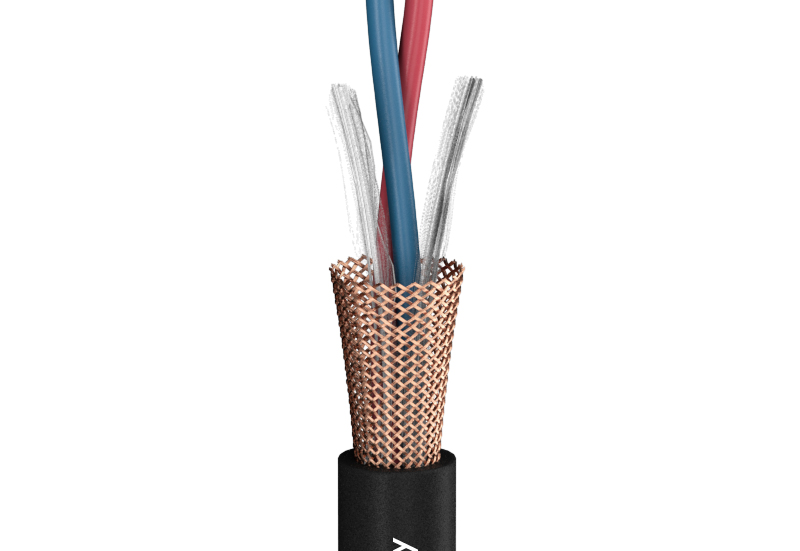It is clear that balanced cables are essential for miking due to their significantly better shielding. But what is the reason behind it? What types of shielding are there and when and where should they be used?
Our expert Pascal Miguet, Product & Sales Manager at SOMMER CABLE, provides in-depth insights into the subject of cable shielding:

Spiral shielding.
The copper shielding known in cable technology as a ‘D-shield’ was once considered to be insufficient in terms of optical shielding. This was because it is complicated to manufacture and the shielding could not be placed very close.
Due to the new gas-foamed insulators, this type of shielding has become important again because the spiral shield does not rub or damage the fragile foamed insulation when moving, bending or buckling. Many simple, inexpensive cables are only insulated with solid, hard PE, so this cannot happen, but of course the electrical values of these cables are less favourable. Our cable production line features modern stranding machines that achieve a shielding density of 99%, which is quite exceptional. By comparison, the maximum shielding density of a braided shield is a maximum of 95% optical coverage. We can guarantee a clean layer and 99% optical coverage even with the relatively inexpensive cable model ‘The Stage’. The spiral shield can be combined with a carbon shield, which then achieves 100% coverage together with the spiral shield.
The advantage of the spiral shield is the flexibility of the cable and the ease of further processing, since the shield only has to be twisted with the thumb and middle finger when soldering, rather than being unraveled. The carbon shielding is conductive (‘semi-conductive’) and ensures that the spiral shielding remains compact even when the guitar cable is moved around a lot, preventing interference such as footfall noise or crosstalk.

Microphone Cable Stage 22 Highflex, 2 x 0,22 mm² | XLR / XLR, HICON
€20.50*
SGHN-0020-SW
Our Stage 22 Highflex is a high-quality and budget-friendly microphone cable with a wire gauge of 2 x 0,22 mm² (AWG 24) in a 6.4 mm thick Super Soft PVC jacket and dense CU helical copper mesh with 99% optical coverage as well as a capacitance of 68pF/m (cond./cond.). It is filled with PVC almost all the way to the core and allows for excellent reeling.We will gladly produce your custom lengths on request!Configuration: 0,20 m Microphone Cable Stage 22 Highflex; 2 x 0,22 mm²; PVC Ø 6,40 mm; black (200-0001)1 x HICON XLR BASIC, 3-pole female, silver-plated contacts, nickel-plated metal housing, conductive surface, black plastic cap, 3-chuck collet strain relief (HI-X3CF-V)1 x HICON Plastic cap, Metal cap for all HICON-XLR connector, plastic (HI-XC-CAP-P)1 x HICON Code ring for HICON XLR straight transparent (HI-XC-TR)1 x HICON XLR BASIC, 3-pole male, silver-plated contacts, nickel-plated metal housing, conductive surface, black plastic cap, 3-chuck collet strain relief (HI-X3CM-V)1 x HICON Plastic cap, Metal cap for all HICON-XLR connector, plastic (HI-XC-CAP-P)1 x HICON Code ring for HICON XLR straight transparent (HI-XC-TR)1 x KARTONAGE-SCMINI
Double-D shielding
Then there is the double spiral shielding – the double-D shielding – in which two shields lie on top of each other, or are separated by an insulating film, so that the two shields are insulated from each other and can also be placed on the contact carrier of the plug connector.
The carbon shielding can be combined with any other copper shielding, but it should be applied in such a way that it can be easily removed with your fingernails during cable assembly. The disadvantage of double-D shielding is that the shielding can slip and these cables can become very easily knotted if they are embedded under an outer sheath that is too thin.

Braided shielding:
This type of shielding is among the most common. It is easy to produce, inexpensive and robust. It can be combined with a carbon shield and an AL/PT foil, which provides very good protection against NF and HF interference. The AL/PT foil is coated on one side with conductive aluminium and on the other side with stretchable polyester to prevent the foil from tearing during movement.
A better variant is the combination of a weakly conductive fleece and the braiding. The fleece makes the cable more flexible, thinner and more pliable. The shielding density and the pitch angle of the braiding are adapted to the field of application of the cable. The pitch of the braiding is not as high for flexible cables as it is for cables for fixed installations.
The disadvantage of the copper braided shield is that it can chafe the foamed wire insulation when moving and bending, and it is very difficult to process in cable assembly. If the outer sheath is too thin, it can make the cable very stiff and inflexible. It is often erroneously claimed that the combination of copper braiding and AL/PT foil provides excellent protection against electromagnetic interference. However, this is not the case in reality. The best EMC shielding is a foil made of MU metal, but this is reluctant to be stranded because it is too stiff and too hard and wears the tools in the cable extrusion. In the meantime, special cable ducts or MU metal bandings are used for this in the installation.

Instrument cable The Spirit XXL, 1 x 0,75 mm² | jack / jack, HICON
€27.20*
SXRJ-0030
THE SPIRIT XXLTHE SPIRIT is every guitarist's dream. Meanwhile it is used by pro musicians worldwide and enjoys the reputation as the top reference in the instrument cable sector. Due to its special stranding technology, the large wire cross-section of 1 x 0.75 mm (0.029 in.) (THE SPIRIT XXL) and its double shielding (semiconductive conductor + Cu shield) face almost no competition on the market. Despite its strong insulation, the black THE SPIRIT cable is reelable without twisting.Configuration: 0,30 m Instrument Cable SC-Spirit XXL; 1 x 0,75 mm²; PVC Ø 6,80 mm; black-tranparent (300-0071)1 x HI-J63M03-D1 x HI-J63M03-D1 x KARTONAGE-SCMINI
You can find the full BEAT article here


